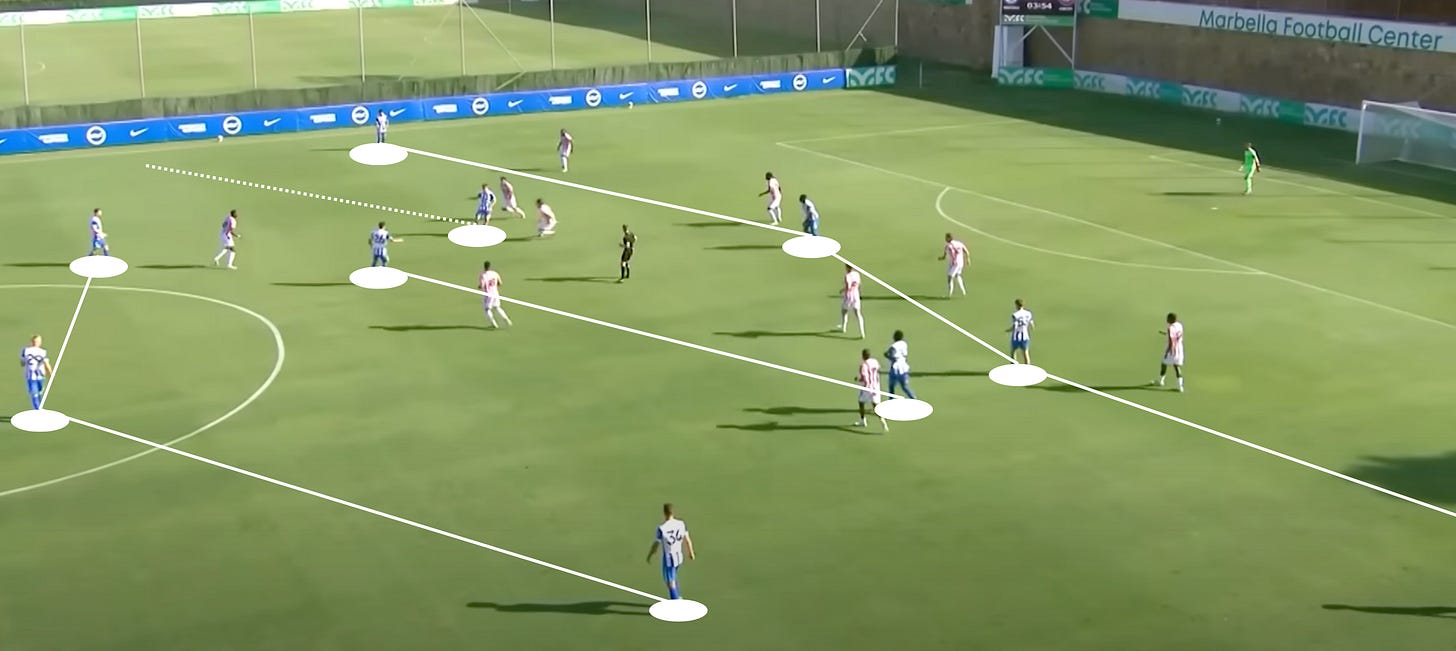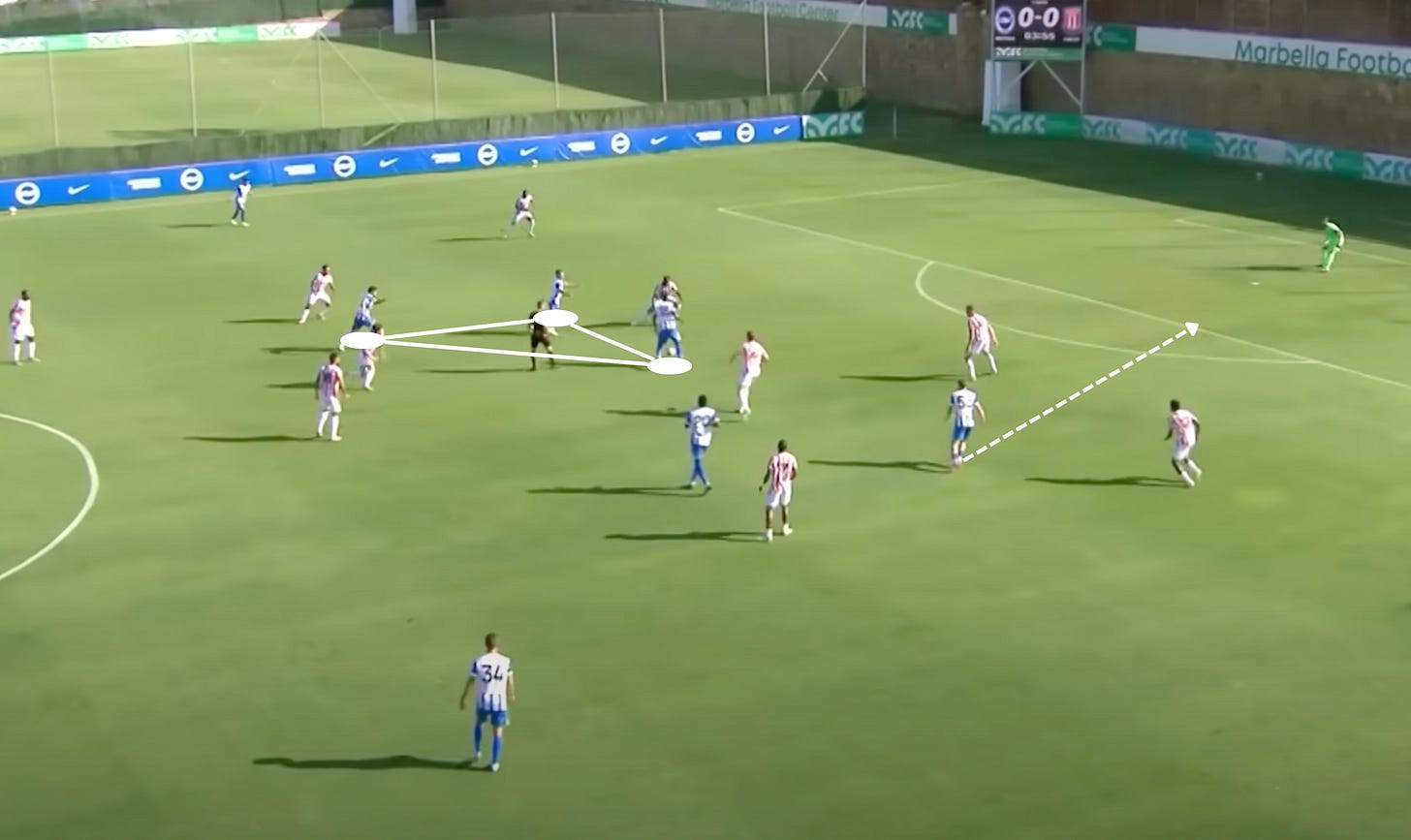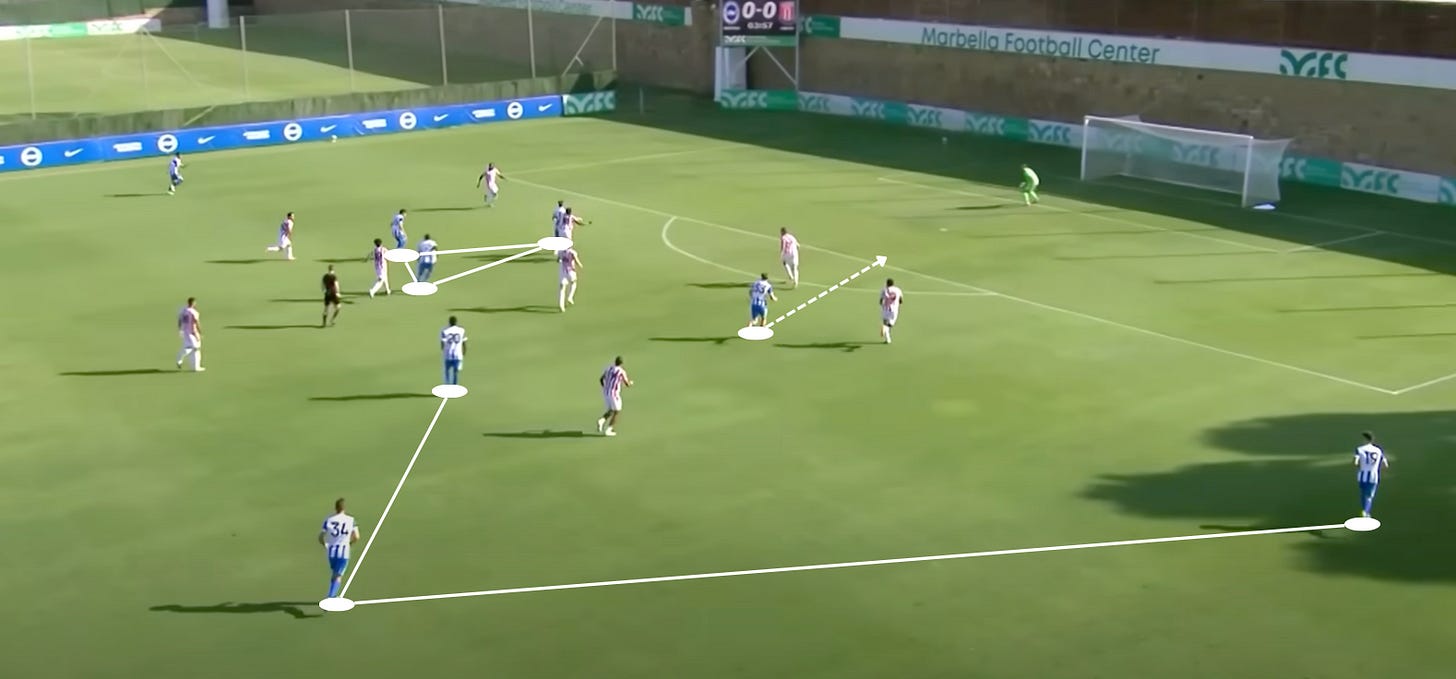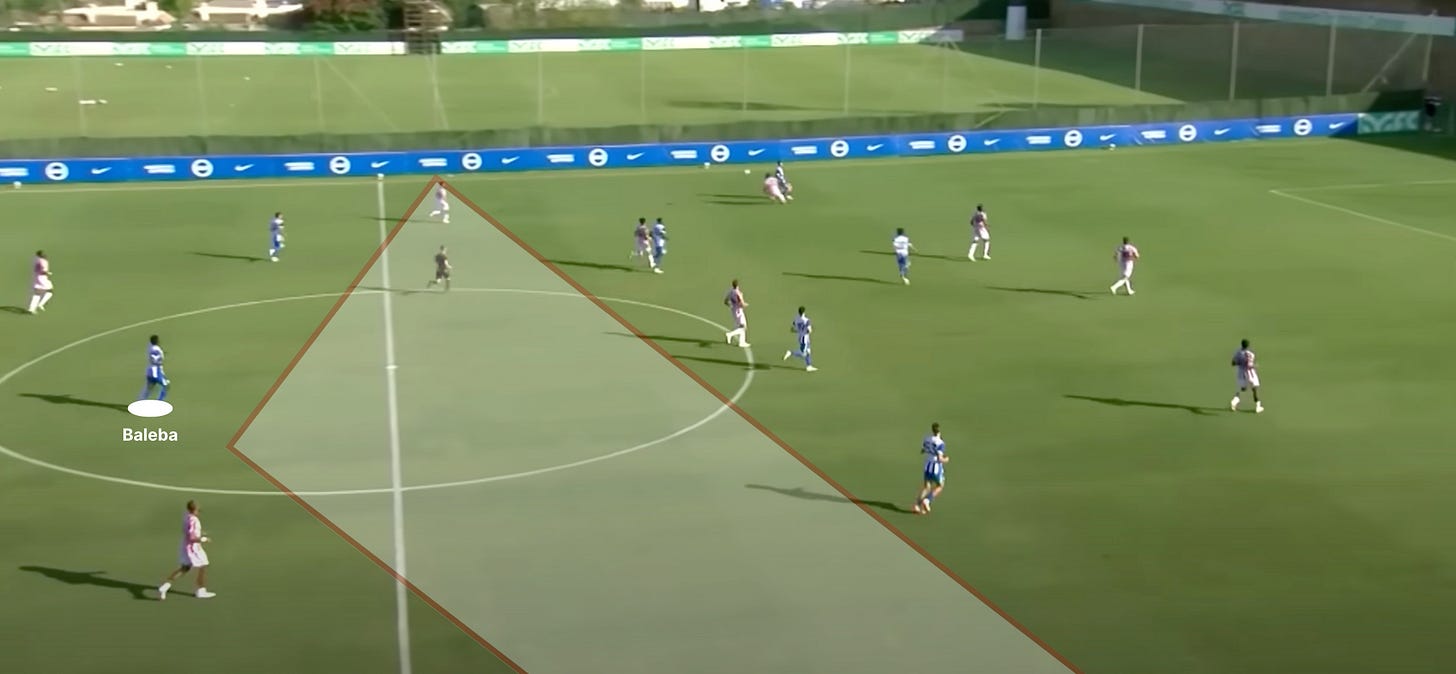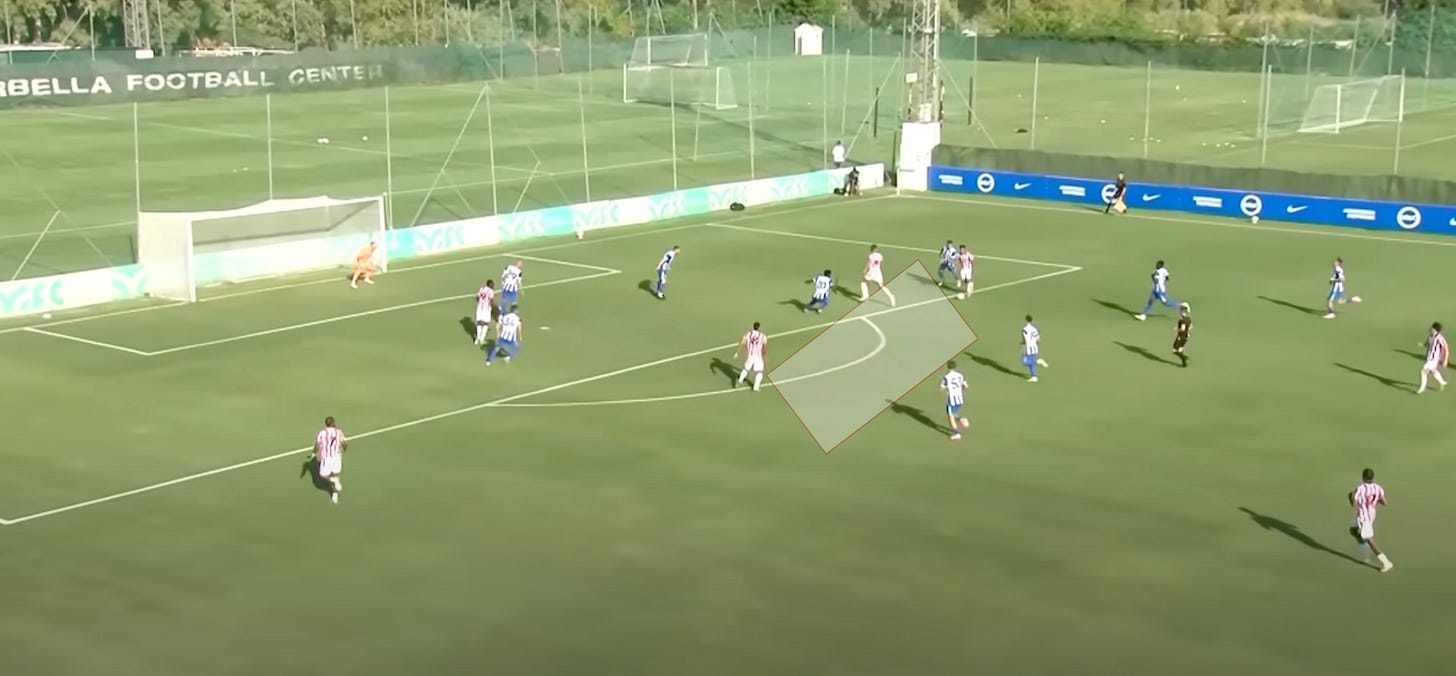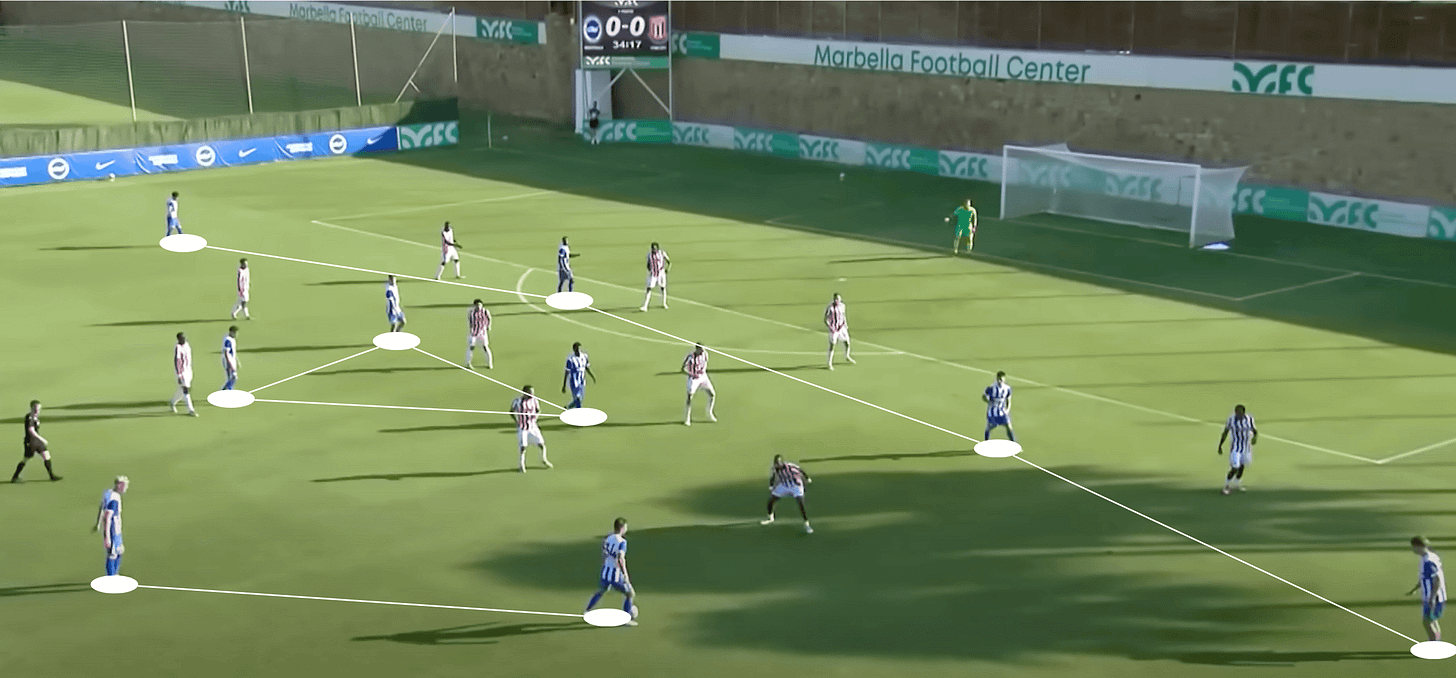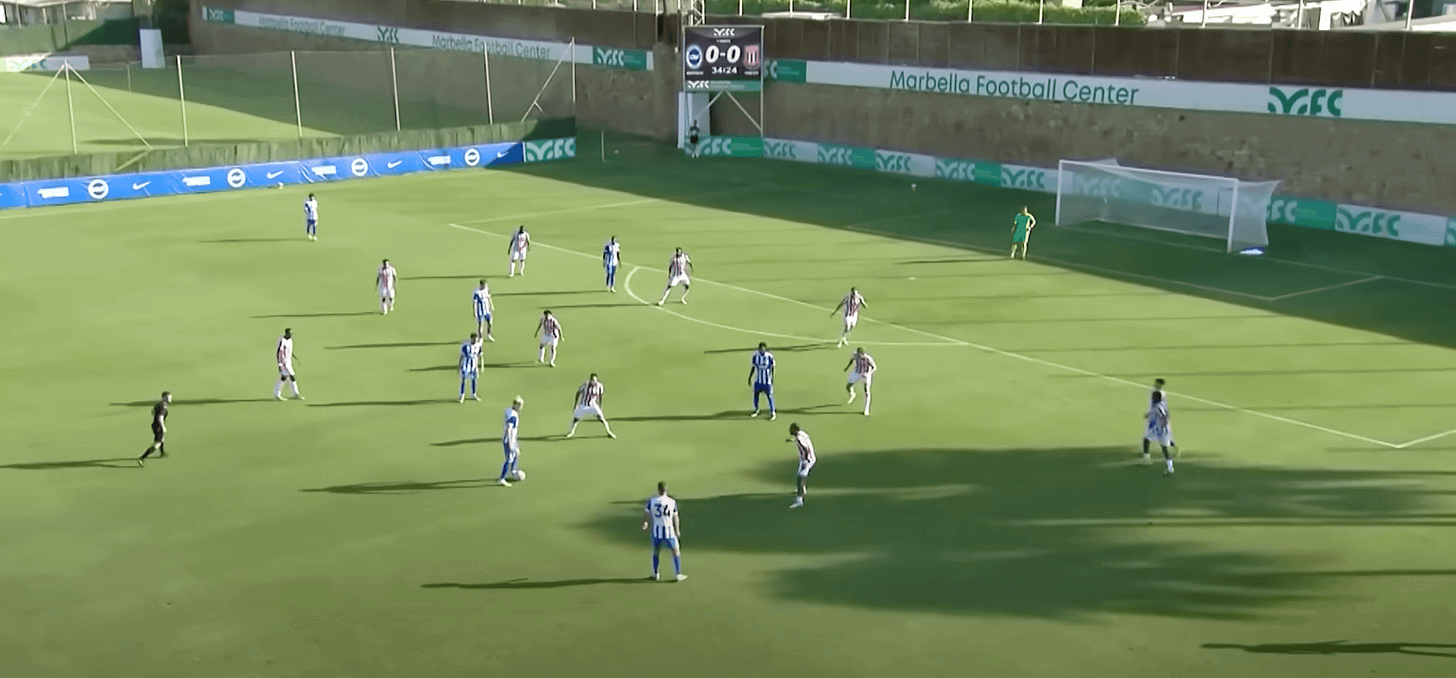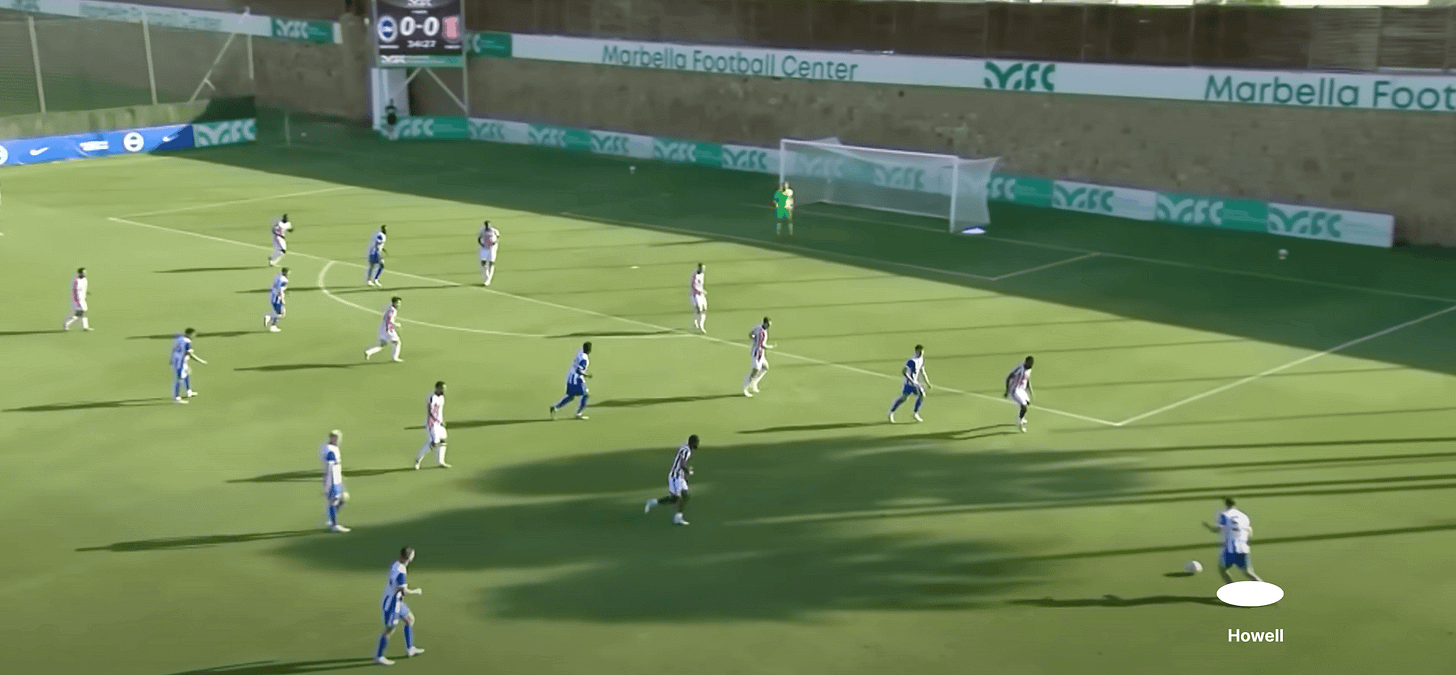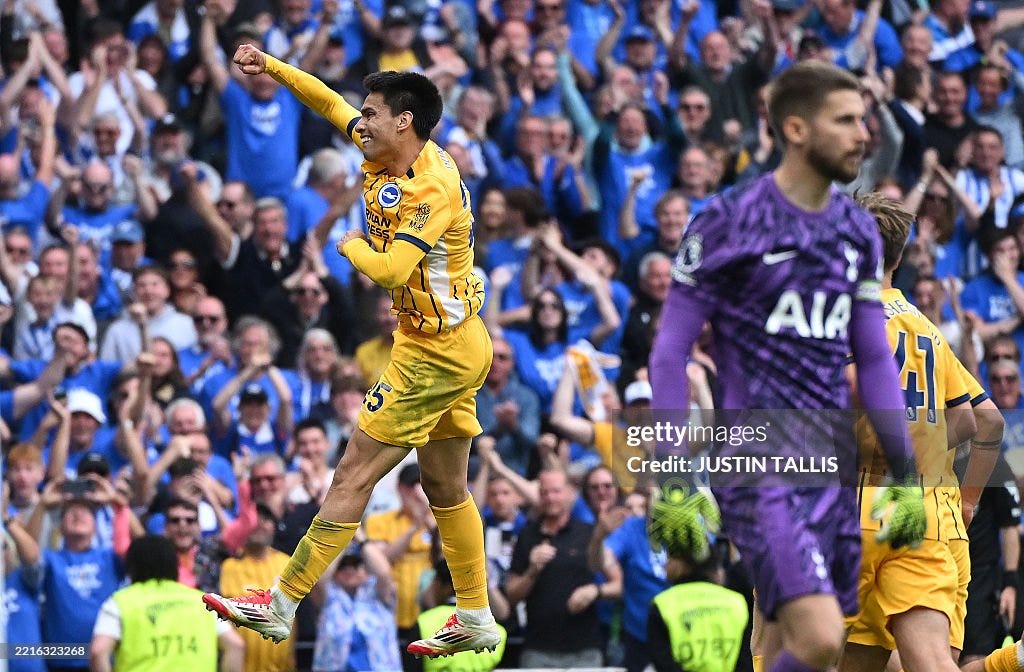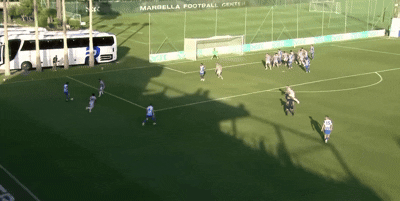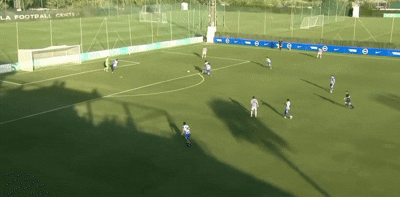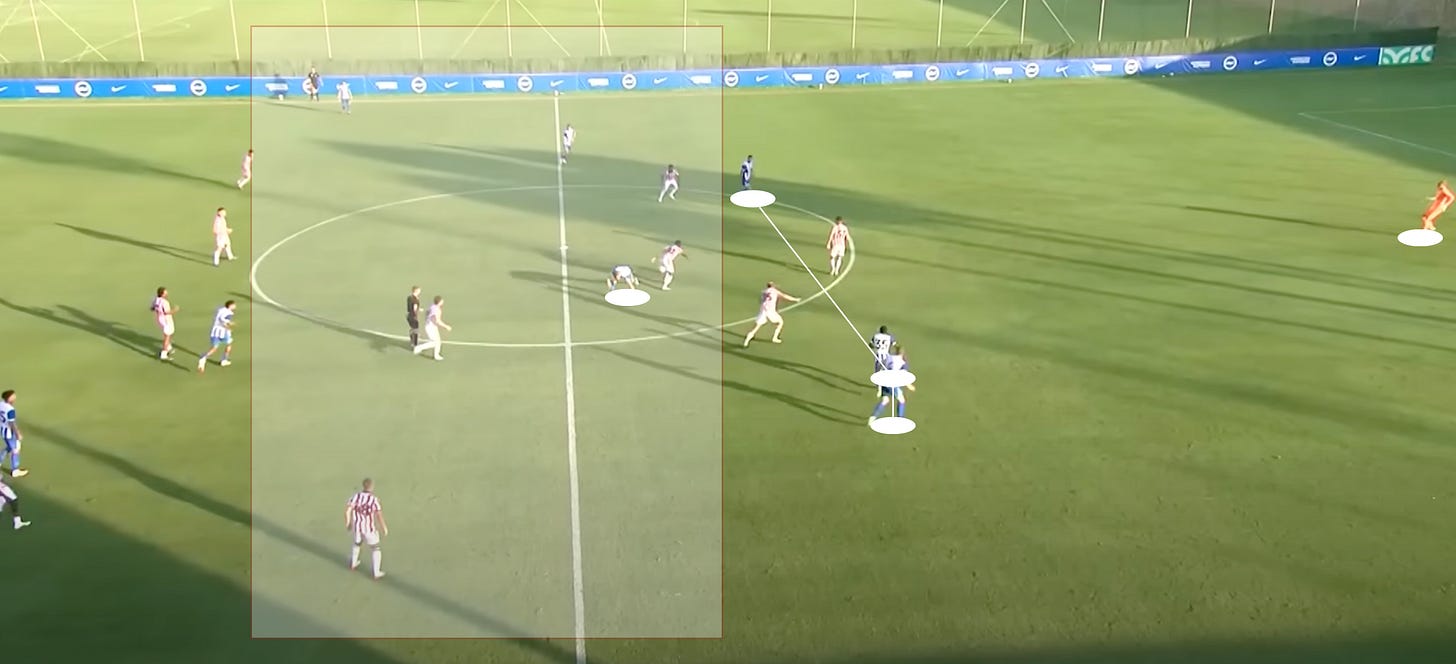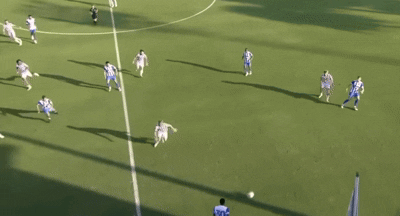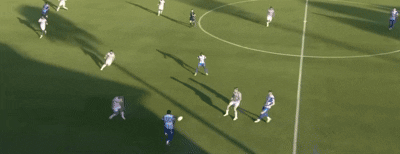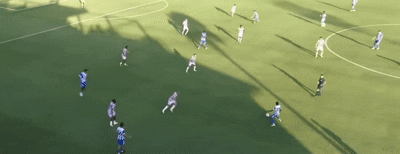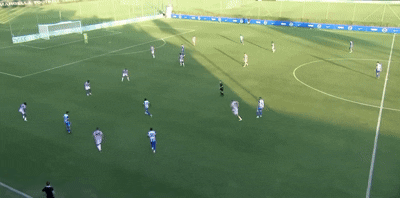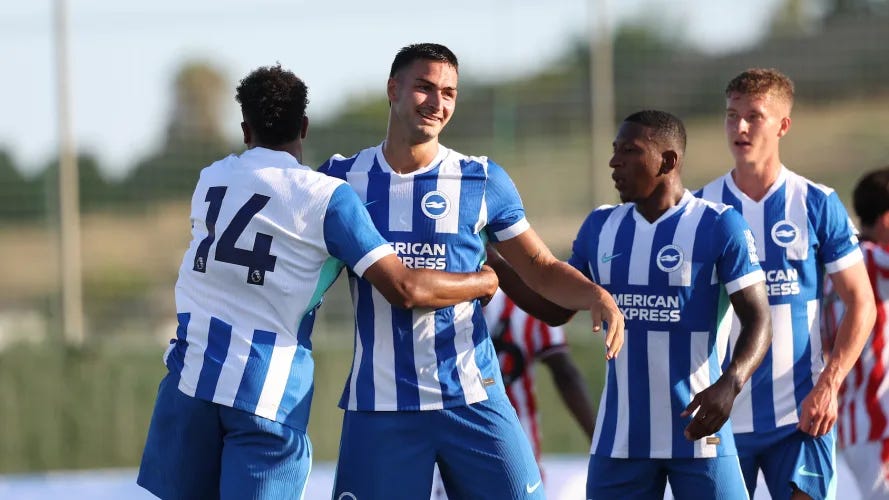Brighton can do it on a sunny afternoon in Spain but can they do it on a cold, rainy night in Stoke?
📚 Contents
Note for email readers: This email is truncated. To read the full article, please click on this link or the link to the right of [Message clipped] note at the bottom of this email.
Lineups (first half):
Build-up play
A couple of things:
Hürzeler gives his players freedom. They occupy space as they see fit and gain mastery over it.
I don’t think Hürzeler was “inverting” Jack Hinshelwood here:
I think Hinshelwood saw some space left open by Yasin Ayari staying deeper [to facilitate build-up play] and simply chose to occupy it, allowing Kaoru Mitoma to push higher up the pitch.
BUT I think Joël Veltman dropping into RCB (and later Jack Hinshelwood into LCB) was a purposeful move to form a back three in possession. Considering all three of Brighton’s CBs at this point (Cashin – van Hecke – Veltman) are good passers, Brighton’s deep passing range from here is rather good. Factor in Carlos Baleba going where he wants and doing what he wants (he often dropped in to play as a CCB during build-up, meaning both fullbacks were high and wide), and you have a) a solid 3-2 rest defence:
———-Ayari Baleba———-
Cashin van Hecke Veltman
and b) good enough passing to provide service to the attacking players by bypassing the opposing midfield.
PyraMIDFIELD
This clip encapsulates Brighton under Hürzeler.
— Ayari stays deep to receive from Cashin
— Hinshelwood stays narrow to occupy the space left behind by Ayari
— Quick 1-2 in midfield
— Pyramids, central overloads, wide isolation
Throughout that entire sequence of play, Yasin Ayari, Jack Hinshelwood, and Danny Welbeck constantly formed pyramids (triangles, but for the sake of the above graphic), meaning they always had two passing options available to them.
And it also meant that Welbeck (or Jack Hinshelwood, given he was at the tip of the triangle) could quite easily release a ball in behind for Andrew Moran to run onto.
As Yasin Ayari ran into space (eventually shooting), this also meant the RHS (Baleba, Veltman, Howell) was completely isolated. Getting the ball into Howell—who could then run into wide open space before crossing to ~4 players in the box—just adds more attacking variety for Brighton and more uncertainty for Stoke’s defenders.
Speaking of Howell running into space, I think his movement was pretty good throughout the game. He filled empty spaces well, whether in or out of possession, and was able to create separation on a consistent basis.
Fluidity in possession
More on the fullbacks, because I found their positioning quite fascinating.
Baleba drops into RCB, Veltman is high and narrow in midfield, with Hinshelwood narrow but deep. Yasin Ayari takes on all responsibility sitting deep in midfield and has four passing options available to him. There's an emphasis on central progression, and once the ball reaches one of the three midfielders, Baleba can bomb forward, occupying Veltman’s zone in midfield, while Veltman and Hinshelwood hold width down the right and left respectively.
Centrally progress until you’re safe in possession, then isolate and overload.
After the first drinks break (~25 minutes in), we started to see Hinshelwood dropping in to form a back three, with Veltman the more advanced option. I imagine this is Hürzeler experimenting with shapes so that both sets of fullbacks are comfortable with either role, which is ultimately quite smart simply for the added mystery it creates. Either way, Estupiñán was brilliant when he came on. He looked fast, looked athletic, and I believe he’s the best fullback Brighton have for this role.
OOPs I forgot my midfield
But for all the good that Brighton did with the ball, what they did without it was… concerning.
Essentially, every single time Brighton turned the ball over, they had no midfield:
So Stoke were largely able to carve through Brighton’s midfield until they got to this position:
Where Brighton simply didn’t have enough pressure on the ball.
Brighton set up pretty decently OOP (4-4-2) when opposing teams are building from the back, but given how aggressive Baleba is told to be (used as a pressing trigger), the midfield is very easily overrun, and you can get dangerously close to Brighton’s goal with ease. Baleba’s athleticism helps a lot here because of how much ground he can cover, but if anyone else were playing there… yikes. Wieffer suits the position, but he just wouldn’t be able to cope with the OOP requirements (yet).
Baleba was pretty good throughout this match. He filled in at RCB, DM, and CM, and was really just given room to roam. He called for the ball frequently, took on his man, and made things happen. Yasin Ayari was often used as a decoy high up the pitch, but was also heavily involved in progressing the ball centrally, often sitting as the lone pivot until Baleba dropped back.
Brighton’s first goal ANDrew Moran
Brighton’s first goal came from (very) settled play:
van Hecke dribbling up the pitch as the CCB, pinning Stoke back:
Howell isolated and ready to receive the ball + drive forward
Mitoma isolated and with room to shoot (and eventually score)
My last point from the first half is that Andrew Moran was good. He pressed hard, moved well into space, took on quite a difficult role, and made it look easy. He’s had a versatile couple of pre-seasons (he played in the pivot last year) and has looked comfortable.
Diego Gómez
Gómez played a little more advanced in this game, pressing as the LF in Brighton’s 4-4-2 OOP shape and largely settling in as the AM when in possession. He started off brilliantly — good associative play, made some smart runs into the box, and got his shots off. It speaks volumes about his skillset, really, given that he was primarily used as a sitting midfielder last season (and was excellent at spraying passes from the back).
Caylan Vickers (Quickers)
I said this about Caylan Vickers in my post-Wycombe match report. It’s not particularly informative, but it was true: Vickers had a really lively game. And that’s true of this match too. His actions are quick ( the speed he executes them at is far better than the level he’s currently playing at) and he’s aware of the space (or lack thereof) around him.
This is a really good cross, especially for someone falling backwards, and his urgency in getting the ball off his foot (for a cross/shot) is a very useful and scalable trait. Vickers was also threatening to make a run in behind, which naturally nags and bites at opposing defenders, pinning them back to the benefit of the entire team (outlet work).
Facundo Buonannote
Buonanotte simply decided to do what did what he did vs. Wycombe again, and that’s good because what he did vs. Wycombe was extremely impressive.
He a) pressed hard and b) used his body well to prevent being knocked off the ball. That leads to a lot of self-created shots, and he’s looking like an excellent option in games where Hürzeler’s looking for ball retention.
That said, Buonanotte has also improved his speed of actions, making his game that bit more direct too. This burst of pace, for example:
Extrapolate everything good I said about Buonanotte, and you have Georginio Rutter’s performances this preseason.
Where’s Wally? Where’s my midfield?
Let’s play a game of Where’s Wally? but instead, let’s try looking for some midfield presence:
A high defensive line can be good: you squeeze your opponent’s space in midfield, and you can counterattack with pace. But what happens in transition?
Again, Brighton have no midfield, their defence is five miles up the pitch, and even Jason Steele is well out of his box. I do think personnel and lack of chemistry affect these things, but even then, this is ultimately a structural flaw—and a rather big one. Most PL teams could simply lump the ball to one of their forwards, who can then lay it off to a midfielder, and with three passes, you’ve conceded another shot on goal. It’s just not great.
Malick Yalcouyé
Yalcouyé was, for lack of a better word or enough hyperbole in the dictionary, incrediblyextraordinarilybrilliant.
He was very comfortable on the ball and was happy to drop deep to collect and lay it off, often even filling in as the CCB:
He lingered on the ball, didn’t panic, and was happy to dribble (especially good in tight spaces) and carry.
This clip piqued my interest. I don’t think 9 out of 10 players would take that route out of the pass (instead of choosing to go backwards), but I suppose it just goes to show how much faith Yalcouyé has in himself.
Yalcouyé’s also able to get this sort of pass off on repeat—high backlift, curving the ball inward, and an exaggerated (inswinging) follow-through. Excellent for switching play.
And to play a ball in behind
His first touch was brilliant, he was nimble and light on his toes, and while some of his passes were either a tad under- or overhit, the fact that he attempted them was impressive enough on its own.
His assist for the last goal was textbook too:
Bends with the ball, perfectly weighted, and the ideal ball to run onto. I think Yalcouyé could go on to become an incredible pivot player if he’s given room to run. A bit of an all-action guy who needs a tall, physical presence next to him. Baleba-esque, but not necessarily someone to play next to Baleba.
Diego Coppola
Two things stood out to me:
Coppola’s work in possession was very forward-thinking. Verona weren’t great last season and he had a lot of grunt work to do, so it’s quite impressive how sharp some of his passes and carries were. He carved through space and is ultimately (more importantly) a brilliant shutdown defender—the latter being something Brighton desperately need.
His recovery pace was weirdly… great? He did well to sweep up balls and win back possession, which you sorta need with the defensive line being as high as it is.
It was a really good debut. A sign of things to come from a profile Brighton need like water in a desert.





